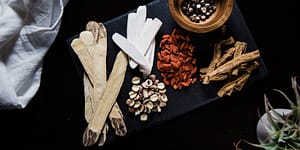Herbal Formulas for Migraines and Other Headaches

Suffering from frequent headaches is miserable and immobilizing. If you haven’t had luck treating and preventing your headaches, skip the over-the-counter approach and prepare herbal formuals for migraines to use in the future!
The following is an excerpt from Herbal Formularies for Health Professionals, Volume 4 by Jill Stansbury. It has been adapted for the web.
Headaches are one of the most common medical complaints treated in general clinical practices and are a significant public health burden in terms of suffering, disrupted family interactions, and lost work and wages. Possible underlying causes of headaches include stress, hormonal influences, vascular inflammation, allergies, dysglycemia, exhaustion, chronic constipation and toxemia, and other phenomena. There are many formal classifications of headaches, and the research into the molecular mechanisms is too extensive to do justice to it in this text. It is the responsibility of the medical clinician to seek out the underlying cause to truly cure the condition and not just provide habitual pain relief. The triptans are the current “gold standard” pharmaceutical for migraine therapy but are effective in only 30 to 70 percent of users, depending on the criteria used to define success.

Acetaminophen, in fact, is a dangerous drug, despite its over-the-counter availability. These pain relievers may also worsen leaky gut and actually increase the occurrence of headaches in those with toxemia and allergic phenomena. Hence, the use of general vasodilating and salicylate herbs, as well as other specific herbs named in this chapter, may be the safest options for treating headaches, especially when combined with dietary, stress-relieving, detoxifying, and antiallergy approaches as specifically indicated.
Food allergies and exposure to mold and toxic environments may also result in chronic headaches. Anti-inflammatory diets and an investigation of work and living environments may be warranted in such cases. Chronic tension headaches are associated with sleep disturbances and sleep apnea, and efforts to improve sleep quality are important.1 A thorough history and intake can typically diagnose the specific type of headache and suggest the most appropriate herbal treatment.
Migraines are not hard to diagnose, and in fact are impossible to miss as a result of the visual disturbance, acute intense onset, accompanying nausea and vomiting, and often a marked spot location or one-sidedness. A combination of addressing underlying contributors (stress, hormonal influences, vascular inflammation) and using specifically indicated herbs as listed at the end of this chapter will often alleviate chronic migraines and tension headaches.
Common Types and Causes of Headaches
Migraines. Such headaches are due to vascular phenomena characterized by a preceding aura, one-sidedness, and rapid onset with throbbing and disabling pain; often accompanied by nausea and vomiting.
Cluster headaches. These headaches are associated with trigeminal autonomic dysregulation. The symptoms of cluster headaches include severe unilateral orbital or supraorbital or temporal pain that is associated with lacrimation, nasal congestion and rhinorrhea, facial sweating, miosis, ptosis, and eyelid edema.
Hormonal headaches. Hormonal changes in relation to the menstrual cycle can cause headaches that occur in a cyclical pattern.
Vascular headaches. High blood pressure or blood reactivity can increase intercranial pressure. Allergic headaches. Histamine-driven inflammatory cytokines can lead to inflammation in the brain. Rebound headaches. Cessation of use of acetaminophen, triptan, ergotamine, and other pain relievers can lead to this type of headache. Sinus headaches. Allergies and sinus congestion cause pressure in the face.
Stress, muscle tension. Tightening muscles in the shoulders, neck, and scalp may induce headaches. Dysglycemia. Low blood sugar and fast blood sugar reactivity can frequently cause headaches. Exhaustion. Fatigue, stress, and overwork can often provoke a dull headache.
Chronic constipation. Dysbiosis, inability to eliminate waste, and increased abdominal pressure as a result of chronic constipation can result in headaches.
Toxemia. Constipation and exposure to environmental toxins can lead to oxidative stress and inflammation.
Altitude. Travel to unaccustomed high altitudes can trigger dull to intense headaches.
Drugs. Many drugs have headaches as a side effect. Dehydration. Hangovers and other causes of dehydration frequently cause headaches in the forehead area.
Caffeine withdrawal. Many daily coffee drinkers experience headaches upon abstinence. Cervical subluxation. Bony displacements in the cervical spine can cause occipital and other headaches.
 Herbal Therapies for Headaches
Herbal Therapies for Headaches
There are similarities between herbal therapies for migraines and those for tension headaches, but migraine formulas may require more vascular anti-inflammatories and mast cell stabilizing herbs, while tension headaches require nervine herbs and muscle relaxants. Salicylate-containing herbs, including Salix species (willow) and Actaea racemosa (black cohosh) can be helpful acutely, but unless specifically indicated may do little to reduce chronic headaches.
Thus, it may be helpful to use two separate formulas—one acute and one chronic—in some cases to take advantage of the anodyne effects of fast-acting palliative herbs, complemented with a deeper acting long-term formula or protocol to correct hormonal imbalance, improve vascular inflammation, treat stress, and improve sleep.
Drugs that reduce sympathetic stimulation of the vascular smooth muscle are commonly used to reduce blood pressure but may also be useful for migraines and heart palpitations where reducing stress-induced vascular tension is helpful.
Reserpine in Rauvolfia serpentina falls in this category, as do various pharmaceutical drugs known as beta-blockers, such as atenolol, propranolol, and metoprolol, which block adrenaline cascades. In addition to Rauvolfia, herbs in this category include Lobelia inflata, Leonurus cardiaca, and Tilia cordata. These may be key herbs in formulas for those with chronic headaches concomitant with stress, hypertension, and possible tachycardia and panic attacks. Additional herbs for headaches due to stress and tension are Piper methysticum, Passiflora incarnata, Valeriana officinalis, Piscidia piscipula, and Actaea.
Compress for Headaches
Hot or cold showers, ice packs, or heating pads may be comforting to those with head pain, and headwashes (washing the head with an herbal tea) are traditional remedies for headaches in some parts of the world. This compress formula may complement any of the tinctures in this section and help speed pain relief; it can be combined with a hydrotherapy technique if desired. A time-honored method of reducing vascular congestion to the head is to place ice on the back of the neck and immerse the feet in hot water to pull blood downward and relieve some of the pressure.
Ingredients
- Capsicum frutescens powder: 2 teaspoons
- Gaultheria procumbens essential oil: 10 to 30 drops
Procedure
- Pour 2 cups boiling water over the Capsicum (cayenne) powder and let stand 10 minutes.
- Strain through a coffee strainer to remove the particulate, which can burn the skin if used in the compress.
- Fold a soft cloth to roughly 4 or 5 inches square, and soak in the strained cayenne tea.
- Shake the drops of oil onto the compress and apply to the nape of the neck and leave in place 20 to 30 minutes. Be sure to keep the compress liquid out of the eyes. The therapy may be complemented by placing an ice pack over the compress and placing the feet in hot water.
Tincture for Migraine Prevention
Some people experience only one or two migraines per year, which makes it difficult to justify the use of a regular preventive agent. However, at times when a person is experiencing migraines several times per week, the use of the following herbs may reduce the frequency and severity of migraines.
Ingredients
- Tanacetum parthenium
- Petasites hybridus
- Zingiber officinale
- Scutellaria baicalensis
Procedure
- Combine in equal parts and take 1 ⁄2 to 1 teaspoon, 3 or more times a day for several months, reducing to once a day for another several months.
- If the use of the tincture is effective, it may be taken in a cyclical fashion, such as one month on, one or two months off.
Tincture for Acute Headaches
Actaea and Salix both contain salicylates, and while aspirin can irritate and ulcerate the digestive mucosa, herbs that contain salicylates have not been shown to do so. In this formula, these herbs are combined with Piper, a powerful muscle relaxant, and Rauvolfia, a powerful vasodilator, to cover the bases for the most common causes of acute headaches. This formula is fairly all-purpose for acute migraines, tension headaches, or simple pain relief, and thus is a useful choice while a case is being evaluated or blood tests are being run.
Ingredients
- Actaea racemosa: 7 ml
- Salix alba: 7 ml
- Piper methysticum: 7 ml
- Rauvolfia serpentina: 7 ml
- Atropa belladonna: 2 ml
Procedure
- Combine ingredients in a 1-ounce bottle.
- Take 1 dropperful of combined tincture every 5 to 15 minutes at the onset of an acute headache, reducing as pain abates.
Notes
1. Jeanetta C. Rains, Rachel E. Davis, and Todd A. Smitherman, “Tension-Type Headache and Sleep,” Current Neurololgy and Neuroscience Reports 15 (2015), article 520, http://doi .org/10.1007/s11910-014-0520-2; Shengyuan Yu and Xun Han, “Update of Chronic Tension-Type Headache,” Current Pain Headache Reports 19 (2015), article 469, http://doi .org/10.1007/s11916-014-0469-5.
Recommended Reads
Recent Articles
Learning how to ask questions that will elicit relevant information is as much an art form as creating an herbal formula. Follow this broad list as a starting point.
Read MoreWant to start your own medicinal herb garden? Passionflower, lemon balm, and goldenseal are great places to begin! These herbs are jam-packed with medicinal properties and easy to grow in a majority of climates.
Read MoreSprouts are easy to cultivate, mature quickly and pack a nutritional punch! You can make nutrient-rich sprouts from all kinds of edible seeds in your kitchen.
Read MoreSuffering from frequent headaches is miserable and immobilizing. If you haven’t had luck treating and preventing your headaches, skip the over-the-counter approach and prepare herbal formuals for migraines to use in the future! The following is an excerpt from Herbal Formularies for Health Professionals, Volume 4 by Jill Stansbury. It has been adapted for the…
Read More











